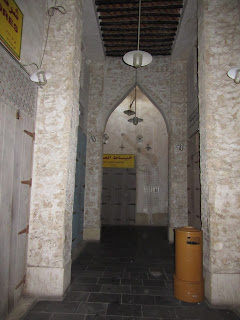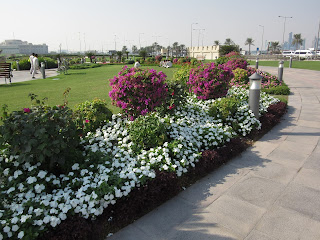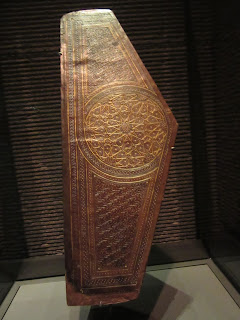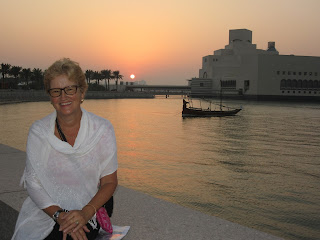From the moment we touched down last night in what surely has to be one of the world’s most beautiful airports, it was evident that Qatar was fabulously wealthy.
I read that Qatar has the world's third largest natural gas reserves and oil reserves and the highest per capita income in the world. Not surprisingly given its mega wealth, Qatar is a significant power in the Arab world, supporting several rebel groups during the Arab Spring both financially and through its globally expanding media group, Al Jazeera Media Network. I couldn't stop admiring the drive in from the airport as, every hundred feet or so, the long line of light poles would change colors. When we got close to them, I noticed they each had elaborate Arabic calligraphy.
We walked from our hotel to the recently overhauled Souk Waqif which was about ten minutes away. There has been a souk or bazaar on the site for centuries as this was the site where the Bedouin - the Arabic-speaking nomadic people of the Middle Eastern deserts - would bring their sheep, goats and wool to trade for essentials.
By the end of the last century, I read that it had become ‘a scruffy warren of concrete alleyways’ which had almost become condemned for demolition. Luckily, somebody spotted its tourist potential and the entire market has been redeveloped so it looked like a 19th century souk.
The venture was so successful that the souk keeps growing to accommodate new ‘old alleyways’ and is one of Doha’s top attractions. It was indeed very appealing to walk around but appeared to be just a bit too ‘sanitized’ to me after seeing many traditional and truly old souks elsewhere.
However, the souk was certainly the place to look for spices, perfumes, fabrics of every color as well as traditional handicrafts.
We enjoyed breakfast at one of the outdoor cafes, watcing the world go by as we ate.
All Qatari men we saw wore the traditional white thobe, a long garment shaped much like a shirt. On their heads, they wore a guthra, a square piece of fabric that was usually checkered with red and white or black and white squares. I was astounded to learn that of Qatar's total population of 1.8 million in 2013, only 278,000 were Qatari citizens. The 1.5 million others were expatriates. As a result, it was easy to tell which men were Qatari or from another nation by their dress.
When is the last time anyone you know used a pressure cooker? I remember my mom had one eons ago but I had forgotten about them altogether until seeing these in the souq.
Turmeric, ginger and so many other spices – too bad we couldn’t bottle up the intriguing scents and take them home with us!
Qatari Muslim women, like their counterparts in other Middle Eastern countries, wore the 'abaya,' a simple, loose black robe that covered them from head to toe over clothing.
Steven especially has been on a potato chip tear when he could find them but we never could figure out what constituted Oman Chips as they tasted just like regular old Lays!A view of one of the city's mosques:
This was a mix used with either chicken or meat and looked far too attractive to pass up getting some to take home.
I couldn’t resist buying some of this red concoction that looked like dried cranberries but the store employee said it was used to cook with rice. I hope a certain family member might like it as she is a far more adventurous cook than I.
We wandered over to the Bird World section of the souk next.
I must admit to not knowing a thing about birds but Steven and I think these prettily-colored birds were parakeets.
As much as I enjoyed wandering through the souk looking at the merchandise, what caught my eye more was just looking at the people.
One of the souk's new 'old alleyways' I mentioned earlier.
Steven had read about Doha having a Falcon Souk which was where we walked over to once we left the regular souk. We have been to souks in many places but had never come across a Falcon Souk before.
All the falcons had a head covering so they would remain calm.
What a sight when we saw men walking around all carrying falcons on their arms.
In five weeks, near the very end of of our trip, we'll be visiting the United Arab Emirates. While in the city of Abu Dhabi, we have reservations to take a tour of the Falcon Hospital there. Our time wandering around Doha's Falcon Souk whetted my appetite to learn something about falcons.
What a hoot seeing the man at the ATM with his falcon. Sure don’t see something like that back home in Denver!
I needed a 20 minute catnap after our late night arrival in Doha so I rested on the fairly comfortable bench in the shade of the falcon souk.
I figured this lovely seating area outside the souk would be packed later in the day when it wasn't so hot.
The National Archive:I admired the building's exterior lacey designs.
The square across from the Archives and the heritage home was absolutely immense and seemed even bigger than Tiananmen Square in Beijing.
To escape the 35 degree heat and take advantage of the shade, we walked back through the souk which was closed daily from 1-4 to access the city's waterfront.
Before reaching the water, we strolled through beautiful Souq Waqif Park. Steven and I were so surprised how green and lush parts of the city were, considering it is so close to the desert.
Janina: I thought of you when I saw these high-backed benches in the small park as I know you like bench photos.
We had to take the pedestrian underpass to the watrfront known as the Corniche. These weren't just your everyday run of the mill signs or posters of Qatar's past but attractive mosaic tiled works of art.
The first thing we saw as we popped up from the underpass was this large Pearl Monument, an homage to Qatar's pearling past.
According to many, the highlight of Doha is unquestionably the 8km long Corniche bordering Doha Bay which was carefully constructed with landfill to make an attractive crescent. We weren't quite up for a walk of that magnitude today so just walked along part of it toward the celebrated Museum of Islamic Art.
Traditional Arab boats known as dhows lined the harbor.Doha's impressive skyline where the business district was, was located across the bay from the souk and the old part of the city.
Because it was a dry heat, it wasn't too uncomfortable to walk around, especially because of the breeze from the water.
Doha had one of the more unusual skylines. It was one we looked forward to seeing close up the next day as we were headed away from the city's West Bay toward the city's biggest museum.
This building looked like it was an ice cream cone but perhaps that was just because I had ice cream on my brain as it was hot!
Qatar's flag looked like it was the same as Bahrain’s until I noticed the red shade was actually a smidge darker.
Like so many of Doha's buildings, it was stark white; it was shaped like an ultra-modern fortress with few windows so as to cut down on energy use.
What a magnificent entrance to the museum with the long path which culminated in the water feature.
Once inside the Museum, we had the sense of being in a mosque with the huge chandelier and the dome common to most large mosques.
Rob Pointon, the International Artist in Residence at Britain's Manchester Airport, was painting the sights of Doha for two months in partnership with Qatar Airways. I had never heard of any airport having an artist in residence before. I wonder how common it is.
Our first destination was the Islamic Art Gallery. According to what we read, art from the Islamic world isn't restricted to any particular kind of object as often found in other cultures. The need to make ordinary objects beautiful demonstrates how art was a part of everyday life. The Gallery showed some of the Museum's collection which ranged geographically from Spain to China and spanned a thousand years. The photos that follow were the items I most admired, found the most intriguing and want to remember.
16th C. Water Bottle from Turkey:
Mid-14th C. Gilded and Enameled Bucket from Egypt or Syria:
10th C. Qur'an aka Koran in Kufic script made with ink and gold on parchment from the Near East or North Africa:
10th C. Earthenware Bowl from Iran with a ship painting:
I would never have known this Late 14th C. Inscription Tile from Central Asia was Islamic if it hadn't been in this museum. It just looked like it had a stunning design to me, not an Islamic one.Ceramic Cenotaph from Central Asia dated from the second half of the 14th C.:
A fabulous wool carpet from Iran, dated the second half of the 16th C.:
When I saw the early 14th C. Iron Gate Plaque from Bagdad, I figured Iraq would be a country we‘ll never likely visit! We may well be fairly adventurous in the places we choose to travel to, but crazy we’re not.
The Figure in Art: Many believe that figural representation is forbidded in the Islamic world but actually the depiction of humans and animals are avoided only in religious contexts such as in mosques. Figures of animals and humans are widely found on all kinds of objects as part of elaborate patterns.
12th C. Monumental Panel with figural scenes molded, carved and painted stucco:
Isn't the detail exquisite?This 16th C. painting from Uzbekistan was titled 'The vizier pleads for the life of a young bandit.’ I have sure heard of all the 'stan' countries but I sure couldn't pick out where they are on a map,
Bowl from Iran from the late 12th or early 13th C.:
12th C. Incense Burner from Iran:The views out to the green waters of Doha Bay from the massive floor to ceiling windows were very impressive.
Science in Art: Scientists of the Muslim world placed emphasis on experimentation, making significant innovations and achievements in astronomy, mathematics, medicine, engineering and other scientific fields. In turn, late medieval European scholars translated these scientific and philosphical texts from Arabic into Latin. The emergence of Muslim intellectual efforts played an essential role in the Renaissance in Western Europe.
The 13th C. book, Treatise on Mechanical Devices, from Egypt or Syria was written with ink and pigments.
This very attractive 17th-18th C. Indian piece titled 'Botanical Illustrations: Illustration from the Marvels of Creation and the Oddities of Existence' was made using opaque watercolor and ink.
I was surprised to see a number of astrolabes in the Art Museum until I learned that they were perfected in the Islamic world and introduced into Europe vis Islamic Spain. Many of the astrolabes, which means 'taker of the stars,' were dated and signed by well-known astonomers, some by master 'dynasties' of craftsmen.
15th C. Map of the World from Egypt or Syria:
This beautiful 16th C. Mosque Lamp from Egypt or Syria was in the next collection titled 'Pattern in Art:'
15th C. Mosaic Tile Panel from Iran:
I marveled at how perfectly preserved this 13th C. Bowl from Iran was. I wondered who had used it through the ages and for what purposes.
Pattern: A number of basic patterns appeared in Islamic art. Geometry and floral motifs remained a constant presence throughout the centuries. The amount of figural representation depended on the religious climate but also on politics and fashion. Animals were often hidden in other patterns.I couldn't fail to admire the vibrant colors that still remained in the Late 15th C. Silk Textile from Spain:
9th-10th C. Earthenware Dish from Iran or Central Asia:
This very intricately carved 11th-12th C. Hunting Horn from Italy was made from ivory and brass.
These 14th C. Book Binding Flaps from Egypt were made from leather and gilding.
We walked upstairs next to the second floor. There we saw this 15th-16th C. Armor for Horse and Rider from Turley and made from steel. I just pitied the poor horse suffering under the weight.
One huge 17th C. Cushion Cover from Iran:
I figured the Jeweled Falcon from India, dating to 1640 and made from gold, diamonds, rubies, sapphires and onyx was in the perfect museum after visiting the Falcon Souk earlier today!
Horse-Headed Dagger and Scabbard from India, dated from 1700:
The rug was an absolute work of art and looked very different depending which end of the rug we viewed it from.
This 14th C. Mosque Lamp came from Egypt.
What an attractive Inlaid Dish from Egypt or Syria that dated from the 15th C. and was made from brass with silver inlay.Pretty fancy 14th C. Egyptian Candlesticks made with brass, gold and silver, don’t you think?
These 11th-12th C. Bracelets from Syria were made for very large wrists.
This Bottle, that dated from 1200 and was from again Egypt or Syria, was the thinnest one I had ever seen. I again wondered what it had been used for.
This Spanish Fountainhead was from the late 10th or early 11th C. and was made from bronze and gilding.Upstairs, we were surprised to see a small gallery devoted to Muhammed Ali and called ‘Tribute to a Legend.’
We spent a few minutes wandering about the Treasures of China Exhibition.
Jacques Chirac, the former President of France, visited China in 1978 when he was the mayor of Paris. He remarked, 'There are Seven Wonders of the World and the discovery of the Terracotta Army, we may say, is the Eighth. No one who has not seen the pyramids can claim to have visited Egypt and now I'd say that no one who has not seen these terracotta figures can claim to have visited China.'Seeing this exhibit reminded us of how incredibly fortunate Steven and I were to have seen the thousands of warriors when we visited Xian, China in 2013.
The Museum's exhibits were exquisitely presented and first class. It was evident that no expense was spared to create such a fabulous collection in an unparalleled setting.
We walked around to the back of the Museum as there was a lovely park and long walkways. The path was lined with Washington Palm Trees.It was only 4:45 but the sun was setting.
What a difference a day makes! Yesterday this time we were stuck in traffic on the King Fahd Causeway in Manama, Bahrain, hoping to see the sunset there.
How utterly magical strolling along to the end of the Corniche amidst the date palms with Doha Bay on our left and the city's skyline stretched out in front of us.
From this angle, it looked like there were eyes on the Museum that followed us as we walked!
This mosque's fanciful minaret was also visible from our hotel room.
The Pottery Jar Fountain marked the corner by the Museum.
True to form, we hadn’t stopped for lunch at all so we were relived to find a restaurant easily enough and that also looked appealing.
We were escorted to the restaurant’s Family Room, i.e. for women as the other part of the restaurant was for men only. Now that was a first for us!
I had been on a freshly squeezed orange juice kick ever since I had had some at our hotel in Giza, Egypt. Every restaurant in the Middle East we had been to served the juice so I was quite content!
We considered our first day in Doha a rousing success and couldn't wait to visit the nearby sand dunes in the morning before exploring more of the city later in the day.
Posted from Nairobi, Kenya on November 21st, 2016.










































































































































































Loved the jeweled Falcon. He was beautiful. Lil Red
ReplyDeleteThe birds are soooo cool! I love how they just take them everywhere. Looks like a lot of scarves everywhere too :)
ReplyDeleteLove and Miss you!!